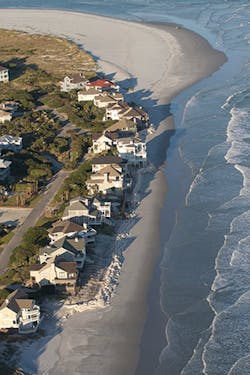WINTER ISN’T BEACH SEASON for most of us in the Northern Hemisphere, but for at least one group, it is—the beach, in fact, is always in season. The group is the Surfrider Foundation, which recently released its 2017 “State of the Beach Report Card.”
The nonprofit organization clearly has an interest in the recreational uses of the nation’s beaches, but it also values the habitat and infrastructure of the coast—and the economic contribution it provides. The “ocean economy” adds more than $352 billion a year to the national gross domestic product. We’ve all got a stake in the beach.
As I pointed out recently in Stormwater magazine, in a discussion of the American Society of Civil Engineers Infrastructure Report Card and similar rating systems, the report card format is an easily understood and sound-bite-friendly way to get information across to the general public; all of us who’ve ever been to school understand immediately what it means. For some of us, it also generates a nagging sense of guilt or failure if the grades are low, and that, too, is what the creators of these reports intend. We might just feel bad enough to take some kind of action. When it comes to our coastlines, the Surfrider report tells us, there’s plenty to be done.
The report includes all coastal and Great Lakes states and Puerto Rico, grading each based on four categories: sediment management, coastal armoring, development, and sea level rise. Sediment management might include projects like beach renourishment but in any case is rated based on how well a state’s policies promote a stable coastline. States rate higher in the armoring category if, for example, they favor soft stabilization measures like living shorelines over riprap and other hard techniques, and if they do not allow emergency permitting for struc- tures right after major storms. The develop- ment category takes into account things like adequate setback buffers and restrictions on building in high-risk areas. The last category considers how well each state is incorporating planning for sea level rise into its policies.
Only eight states received a grade of A or B overall, while 13 got a D or F. One of the biggest threats the report identifies is coastal ero sion; it causes $500 million in property losses each year, despite the $150 million the federal government spends on mitigation measures. Most of the states that experience extreme weather events do not have solid coastal preservation or sea level rise policies in place.
You can download the full 82-page report at http://bit.ly/2ne6Jv7. It includes detailed descriptions of the methodology used in rating each category, plus a breakdown by state and region. If you’re in a coastal state, take a look and see where you stand—and let us know whether you agree with the report and its categories, or what else you think should be emphasized. You can send an email to [email protected] or leave a comment below.
About the Author
Janice Kaspersen
Janice Kaspersen is the former editor of Erosion Control and Stormwater magazines.


